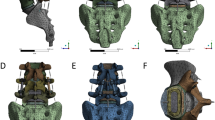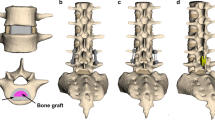Abstract
Interbody fusions have become increasingly popular to achieve good fusion rates. Also, unilateral instrumentation is favored to minimize soft tissue injury with limited hardware. Limited finite element studies are available in the literature to validate these clinical implications. A three-dimensional, non-linear ligamentous attachment finite element model of L3-L4 was created and validated. The intact L3-L4 model was modified to simulate procedures like laminectomy with bilateral pedicle screw Instrumentation, transforaminal, and posterior lumbar interbody fusion (TLIF and PLIF, respectively) with unilateral and bilateral pedicle screw instrumentation. Compared to instrumented laminectomy, interbody procedures showed a considerable reduction in range of motion (RoM) in extension and torsion (6% and 12% difference, respectively). Both TLIF and PLIF showed comparable RoM in all movements with < 5% difference in reduction of RoM between them. Bilateral instrumentation showed a more significant decrease in RoM (> 5% difference) in the entire range of motion except in torsion when compared to unilateral instrumentation. The maximum difference in reduction in RoM was noted in lateral bending (24% and 26% for PLIF and TLIF, respectively), while the least difference in Left torsion (0.6% and 3.6% for PLIF and TLIF, respectively) in comparing bilateral with unilateral instrumentation. Interbody fusion procedures were found to be biomechanically more stable in extension and torsion than the instrumented laminectomy. Single-level TLIF and PLIF achieved a similar reduction in RoM with a < 5% difference. Bilateral screw fixation proved biomechanically superior to unilateral fixation in the entire range of motion except in torsion.
Graphical Abstract









Similar content being viewed by others
References
Ravindra VM, Senglaub SS, Rattani A, Dewan MC, Härtl R, Bisson E, Park KB, Shrime MG (2018) Degenerative Lumbar Spine Disease: Estimating Global Incidence and Worldwide Volume. Global Spine J 8(8):784–794
Gibson JA, Grant IC, Waddell G (1999) The Cochrane review of surgery for lumbar disc prolapse and degenerative lumbar spondylosis. Spine 24(17):1820–1832
Yadav S, Singh S, Arya RK, Kumar A, Kumar I, Jha A (2020) Comparative analysis of transforaminal lumbar interbody fusion versus posterolateral instrumented fusion in degenerative lumbar spine disorders. J Orthop, Trauma Rehabil 27(2):173–178
Høy K, Bünger C, Niederman B, Helmig P, Hansen ES, Li H, Andersen T (2013) Transforaminal lumbar interbody fusion (TLIF) versus posterolateral instrumented fusion (PLF) in degenerative lumbar disorders: a randomized clinical trial with 2-year follow-up. Eur Spine J 22(9):2022–2029
Zhang BF, Ge CY, Zheng BL, Hao DJ (2016) Transforaminal lumbar interbody fusion versus posterolateral fusion in degenerative lumbar spondylosis: A meta-analysis. Med 95(40):e4995
Mobbs RJ, Phan K, Malham G, Seex K, Rao PJ (2015) Lumbar interbody fusion: techniques, indications and comparison of interbody fusion options including PLIF, TLIF, MI-TLIF, OLIF/ATP, LLIF and ALIF. J Spine Surg 1(1):2–18
de Kunder SL, van Kuijk SM, Rijkers K, Caelers IJ, van Hemert WL, de Bie RA, van Santbrink H (2017) Transforaminal lumbar interbody fusion (TLIF) versus posterior lumbar interbody fusion (PLIF) in lumbar spondylolisthesis: a systematic review and meta-analysis. Spine J 17(11):1712–1721
Lan T, Hu SY, Zhang YT, Zheng YC, Zhang R, Shen Z, Yang XJ (2018) Comparison between posterior lumbar interbody fusion and transforaminal lumbar interbody fusion for the treatment of lumbar degenerative diseases: a systematic review and meta-analysis. World Neurosurg 112:86–93
Sim HB, Murovic JA, Cho BY, Lim TJ, Park J (2010) Biomechanical comparison of single-level posterior versus transforaminal lumbar interbody fusions with bilateral pedicle screw fixation: segmental stability and the effects on adjacent motion segments. J Neurosurg Spine 12(6):700–708
Xu H, Tang H, Guan X, Jiang F, Xu N, Ju W, Zhu X, Zhang X, Zhang Q, Li M (2013) Biomechanical comparison of posterior lumbar interbody fusion and transforaminal lumbar interbody fusion by finite element analysis. Operative Neurosurg 72(1):21–26
Ames CP, Acosta FL Jr, Chi J, Iyengar J, Muiru W, Acaroglu E, Puttlitz CM (2005) Biomechanical comparison of posterior lumbar interbody fusion and transforaminal lumbar interbody fusion performed at 1 and 2 levels. Spine 30(19):E562–E566
Liu H, Xu Y, Yang S-D, Wang T, Wang H, Liu FY, Ding WY (2017) Unilateral versus bilateral pedicle screw fixation with posterior lumbar interbody fusion for lumbar degenerative diseases: a meta-analysis. Med 96(21):e6882
Zhao Y, Yang S, Ding W (2019) Unilateral versus bilateral pedicle screw fixation in lumbar fusion: A systematic review of overlapping meta-analyses. PLoS One 14(12):e0226848
Ambati DV, Wright EK Jr, Lehman RA Jr, Kang DG, Wagner SC, Dmitriev AE (2015) Bilateral pedicle screw fixation provides superior biomechanical stability in transforaminal lumbar interbody fusion: a finite element study. Spine J 15(8):1812–1822
Chen SH, Lin SC, Tsai WC, Wang CW, Chao SH (2012) Biomechanical comparison of unilateral and bilateral pedicle screws fixation for transforaminal lumbar interbody fusion after decompressive surgery–a finite element analysis. BMC Musculoskelet Disord 13(1):72
Umale S, Yoganandan N, Baisden JL, Choi H, Kurpad SN (2022) A biomechanical investigation of lumbar interbody fusion techniques. J Mech Behav Biomed Mater 125:104961
Fagan MJ, Julian S, Mohsen AM (2002) Finite element analysis in spine research. Proc Inst Mech Eng 216(5):281–298
Chen CS, Cheng CK, Liu CL, Lo WH (2001) Stress analysis of the disc adjacent to interbody fusion in lumbar spine. Med Eng Phys 23(7):483–491
Pintar FA, Yoganandan N, Myers T, Elhagediab A, Sances A Jr (1992) Biomechanical properties of human lumbar spine ligaments. J Biomech 25(11):1351–1356
Rohlmann A, Bauer L, Zander T, Bergmann G, Wilke HJ (2006) Determination of trunk muscle forces for flexion and extension by using a validated finite element model of the lumbar spine and measured in vivo data. J Biomech 39(6):981–989
Goel V, Monroe B, Gilbertson L, Brinckmann P (1995) Interlaminar shear stresses and laminae separation in a disc: finite element analysis of the L3–L4 motion unit subjected to axial compressive loads. Spine 20(6):689–698
Yamamoto I, Panjabi MM, Crisco T, Oxland TOM (1989) Three-dimensional movements of the whole lumbar spine and lumbosacral joint. Spine 14(11):1256–1260
Zander T, Rohlmann A, Klöckner C, Bergmann G (2003) Influence of graded facetectomy and laminectomy on spinal biomechanics. Eur Spine J 12(4):427–434
Farrokhi MR, Yadollahikhales G, Gholami M, Mousavi SR, Mesbahi AR, Asadi-Pooya AA (2018) Clinical Outcomes of Posterolateral Fusion Versus Posterior Lumbar Interbody Fusion in Patients with Lumbar Spinal Stenosis and Degenerative Instability. Pain Physician 21(4):383–406
Yijian Z, Hao L, Huilin Y, Bin P (2018) Comparison of posterolateral fusion and posterior lumbar interbody fusion for treatment of degenerative spondylolisthesis: Analysis of spino-pelvic sagittal balance and postoperative chronic low back pain. Clin Neurol Neurosurg 171:1–5
Campbell RC, Mobbs RJ, Lu VM, Xu J, Rao PJ, Phan K (2017) Posterolateral Fusion Versus Interbody Fusion for Degenerative Spondylolisthesis: Systematic Review and Meta-Analysis. Global Spine J 7(5):482–490
Lu T, Lu Y (2019) Comparison of Biomechanical Performance Among Posterolateral Fusion and Transforaminal, Extreme, and Oblique Lumbar Interbody Fusion: A Finite Element Analysis. World Neurosurg 129:e890–e899
Vamvanij V, Ferrara LA, Hai Y, Zhao J, Kolata R, Yuan HA (2001) Quantitative changes in spinal canal dimensions using interbody distraction for spondylolisthesis. Spine 26(3):B1–B6
Park JS, Kim YB, Hong HJ, Hwang SN (2005) Comparison between posterior and transforaminal approaches for lumbar interbody fusion. J Korean Neurosurg Soc 37(5):340–344
Lu P, Pan T, Dai T, Chen G, Shi K (2018) Is unilateral pedicle screw fixation superior than bilateral pedicle screw fixation for lumbar degenerative diseases: a meta-analysis. J Orthop Surg Res 13(1):296
Ren C, Qin R, Sun P, Wang P (2017) Effectiveness and safety of unilateral pedicle screw fixation in transforaminal lumbar interbody fusion (TLIF): a systematic review and meta-analysis. Arch Orthop Trauma Surg 137(4):441–450
Kim HJ, Kang KT, Chang BS, Lee CK, Kim JW, Yeom JS (2014) Biomechanical analysis of fusion segment rigidity upon stress at both the fusion and adjacent segments: a comparison between unilateral and bilateral pedicle screw fixation. Yonsei Med J 55(5):1386–1394
Yang M, Sun G, Guo S, Zeng C, Yan M, Han Y, Xia D, Zhang J, Li X, Xiang Y, Pan J, Li L, Tan J (2017) The Biomechanical Study of Extraforaminal Lumbar Interbody Fusion: A Three-Dimensional Finite-Element Analysis. J Healthc Eng 2017:1–8
Slucky AV, Brodke DS, Bachus KN, Droge JA, Braun JT (2006) Less invasive posterior fixation method following transforaminal lumbar interbody fusion: a biomechanical analysis. Spine J 6(1):78–85
Author information
Authors and Affiliations
Contributions
Conceptualization: Nagaraj Manju Moger, Manish Kumar, Subrato Sarkar, Indra Vir Singh, Pankaj Kandwal;
Methodology: Shivam Saini, Manish Kumar, Subrato Sarkar;
Formal analysis and investigation: Nagaraj Manju Moger, Shivam Saini, Manish Kumar, Subrato Sarkar, Samarth Mittal;
Writing—original draft preparation: Nagaraj Manju Moger, Samarth Mittal, Syed Ifthekar, Kaustubh Ahuja;
Writing—review and editing: Manish Kumar, Subrato Sarkar;
Resources: Indra Vir Singh;
Supervision: Indra Vir Singh, Pankaj Kandwal.
Corresponding author
Ethics declarations
Presentation
The authors declare that any portion of the contents of the paper has not been presented previously.
Ethics approval
We conducted our study after obtaining institutional ethical clearance from the ethical committee of AIIMS Rishikesh, India.
Conflict of interest
The authors declare no competing interests.
Additional information
Publisher's note
Springer Nature remains neutral with regard to jurisdictional claims in published maps and institutional affiliations.
Rights and permissions
Springer Nature or its licensor (e.g. a society or other partner) holds exclusive rights to this article under a publishing agreement with the author(s) or other rightsholder(s); author self-archiving of the accepted manuscript version of this article is solely governed by the terms of such publishing agreement and applicable law.
About this article
Cite this article
Saini, S., Moger, N.M., Kumar, M. et al. Biomechanical analysis of Instrumented decompression and Interbody fusion procedures in Lumbar spine: a finite element analysis study. Med Biol Eng Comput 61, 1875–1886 (2023). https://doi.org/10.1007/s11517-023-02825-y
Received:
Accepted:
Published:
Issue Date:
DOI: https://doi.org/10.1007/s11517-023-02825-y




